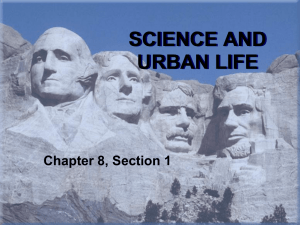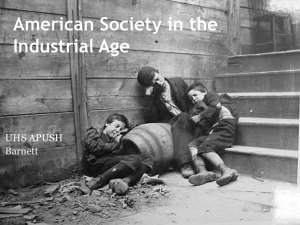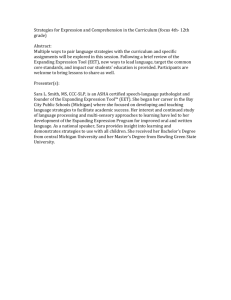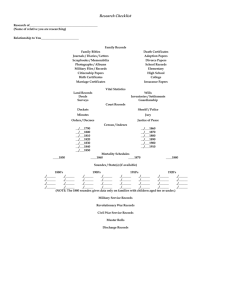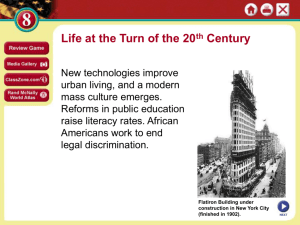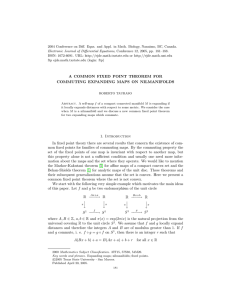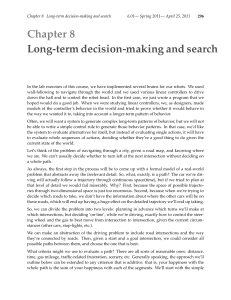Science and Urban Life - Strongsville City Schools
advertisement
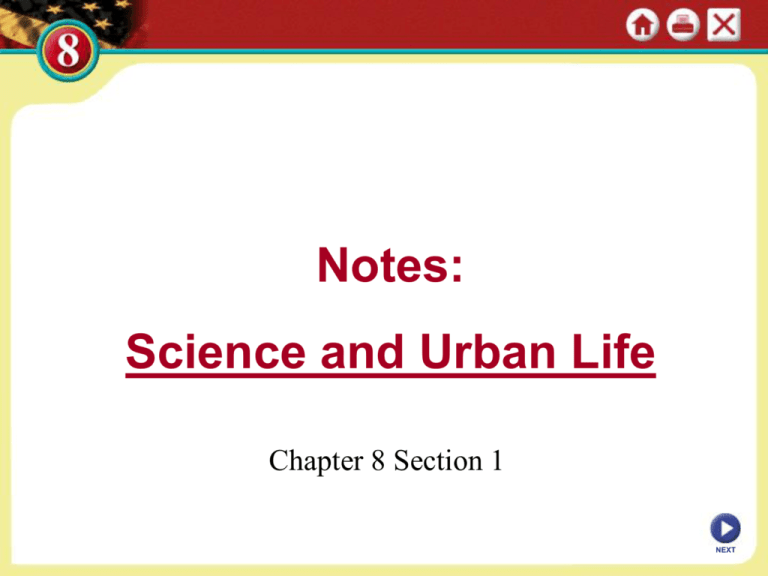
Notes: Science and Urban Life Chapter 8 Section 1 NEXT SECTION 1 Science and Urban Life I.) Technology and City Life A. Skyscrapers • 1890, 58 cities have 50,000 people; • 1900, 4 of 10 people in cities • Outcome: growing urban population = limited space • Invention of elevators, internal steel skeletons lead to skyscrapers - Louis Sullivan designs Wainwright Building in St. Louis - Daniel Burnham designs Flatiron Building in New York City Continued . . . NEXT SECTION 1 B. Electric Transit • Before Civil War, horse-drawn streetcars run on iron rails • By 1900, electric streetcars (trolleys) run from suburbs to downtown • Some cities build elevated trains or subways • Outcome: allow cities and people to spread outward Continued . . . NEXT SECTION 1 continued Technology and City Life C. Engineering and Urban Planning • Steel-cable suspension bridges link city sections • Need for open spaces inspires science of urban planning Frederick Law Olmstead: spearheads movement for planned urban parks - 1857, helps design Central Park - 1870’s planned landscaping for Washington D.C. & St. Louis D. City Planning • Chicago’s population growth results in unregulated expansion • Daniel Burnham: draws plan for Chicago with parks along Lake Michigan (lasting legacy) Image NEXT SECTION 1 New Technologies E. Revolution in Printing • By 1890, U.S. literacy rate almost 90% • Growing demand for newspapers, magazines, books • Mills produce cheap paper that withstands high-speed presses • Outcome: Faster production, lower costs make periodicals more affordable (Penny Press) Continued . . . NEXT SECTION 1 F. Airplanes • Orville, Wilbur Wright use engines to fly “heavierthan-air” craft - first successful flight Dec. 1903 • By 1920, first transcontinental air mail established G. Photography Explosion • Pre-1880s, photography requires heavy equipment, time • George Eastman develops light-weight equipment, studio processing • 1888, introduces Kodak camera, easy to operate - helps create field of photojournalism Image NEXT SECTION 2 Expanding Public Education II.) Expanding Public Education Chart A. Schools for Children • 1865–1895, states pass laws requiring school attendance for children 8-14 years of age • Kindergartens—originally childcare for working women—become popular • 1880, 62% white children, 34% black children in elementary school B. The Growth of High Schools • Industrial economy demands technical, managerial skills • 1900, more than half a million students in high school • Expanding education changes American society Continued . . . NEXT SECTION 2 C. Racial Discrimination • Small percentage of black teenagers attend high school • Most attend private schools that get no government support D. Education for Immigrants • Immigrants encouraged to attend school, be Americanized • Some resent suppression of their native languages • Many public school systems have readings from Protestant Bible - Catholics have parochial schools • Adults attend night school, some day programs at work - unionists object to employer programs NEXT SECTION 2 III.) Expanding Higher Education A. Changes in Universities • By turn of century, 2.3% of youth attend college • 1880–1920, college enrollment more than quadruples • Research universities emerge, offer new curriculum • Professional law, medical schools established • Private universities have entrance exams - some state colleges want high school diploma Continued . . . NEXT 2 I m a g e SECTION B. Higher Education for African Americans Not enough black college graduates to meet needs of communities Booker T. Washington:—racism will end if blacks get labor skills Founded the Tuskegee Normal and Industrial Institute: to teach African-Americans useful skills in agriculture, domestic, or mechanical work or to help get teaching diplomas W. E. B. Du Bois: first African American to get Harvard doctorate Founds Niagara Movement to encourage liberal arts study - believes well-educated future leaders needed NEXT

